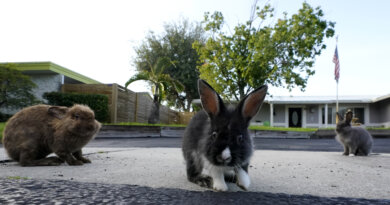What You Need to Know About Canine Lumps and Bumps
Some of the most caring, educated and vigilant pet owners tend to ignore the little lumps until they become colossal catastrophes. Yep, it was going to be one of those days.
Sitting calmly on my exam table was the cutest Chihuahua you could cradle in two hands. Chloe was “103/4” according to her owner, a smartly dressed young woman who couldn’t have been more than a teenager when Chloe was born. The problem was obvious: a dime-sized mass caked in dried blood protruded from Chloe’s left shoulder.
“It was only a tiny bump until a couple of months ago. My groomer has been watching it and said it looked fine. It started bleeding after her last haircut, and now it’s growing like crazy.”
I gingerly began feeling around the base of the mass, carefully watching Chloe for any signs of discomfort. The base of the swelling was hot and inflamed. As I applied pressure, Chloe informed me she’d had enough. I knew what we needed to do next.
Benign or dangerous?
Skin tumors and growths come in a tremendous variety of types: from deadly cancers, such as malignant melanoma, squamous cell carcinoma and mast cell tumors to benign warts, skin tags, cysts, abscesses and hair follicle tumors. The challenge is distinguishing a relatively harmless bump from a lethal lump — they can look the same.
Related: Skin Tags on Dogs — What to Know
To tell the difference, you need to study the cells inside the mass using fine-needle aspiration (FNA) or a surgical biopsy. If you’re female, you’ve heard the importance of having any lump or bump in your breast or underarm area aspirated immediately. For over 30 years, this quick and safe procedure has saved innumerable lives and spared countless women surgery. FNA is also essential in dogs, but many owners aren’t aware. Chloe was a reminder of the importance of “Don’t delay, FNA today.”
Don’t ignore those bumps
Too many times in my career I’ve had to inform a loving dog owner that the little “freckle” or “cyst that’s been there forever” was actually an aggressive malignant cancer. Too many times I’ve wished I could go back in time and take an FNA that could have saved a life. Too many times I had to clutch a paw as a grieving pet parent sobbed, knowing things could have turned out differently if only they’d acted sooner. Dogster family, help share this important message. If you or someone you know notices an unusual skin discoloration (especially “dark and domed”), any lump or bump (no matter how small or insignificant) or just plain “weird skin” on any pet, have it checked by a veterinarian ASAP. Together we can save lives.
How FNA works
I explained to Chloe’s mom that I wanted to numb the area surrounding the mass and insert a needle into the swelling. I’d aspirate some cells and examine them under a microscope.
Based on our findings, we’d either remove the mass or submit the cells for a pathologist to review. It’s critical to determine if the mass is malignant or benign before proceeding with surgery. If the tumor is cancerous, the key to successful treatment and reducing the risk of spreading (metastasis) is to excise the malignancy with a wide, deep margin. If it’s a benign cyst or growth, you can be quicker and more cosmetic by only removing the mass.
Chloe’s mom agreed, and I got to work. After anesthetizing the area around the bloody mass using bupivacaine and buprenorphine, I carefully began my FNA. I chose this combination because I was hoping it would be a benign growth and that combination was perfect for a quick surgery. I’d also been a veterinarian long enough to have been fooled more than once when guessing the origin of a skin tumor.
As I collected the aspirate, I began to feel more optimistic. The mass contained fluid and pus, which I confirmed under the microscope. I continued scanning for any sign of suspicious or malignant cells and found none. I relayed my observations to the owner, and we elected to remove the mass and submit it for a full biopsy. Forty minutes later Chloe was back in her mom’s arms with a neat row of “cute little baby stitches!”
The next day the pathologist confirmed the mass was an infected benign follicular tumor. Chloe would be fine.
“Dr. Ward, thank you so much,” said the owner. “I feel terrible for ignoring the bump until it grew so big. I promise I’ll never wait again!” And that’s a promise all of us should make.
Top photograph: Bill Bachman | Alamy Stock Image




